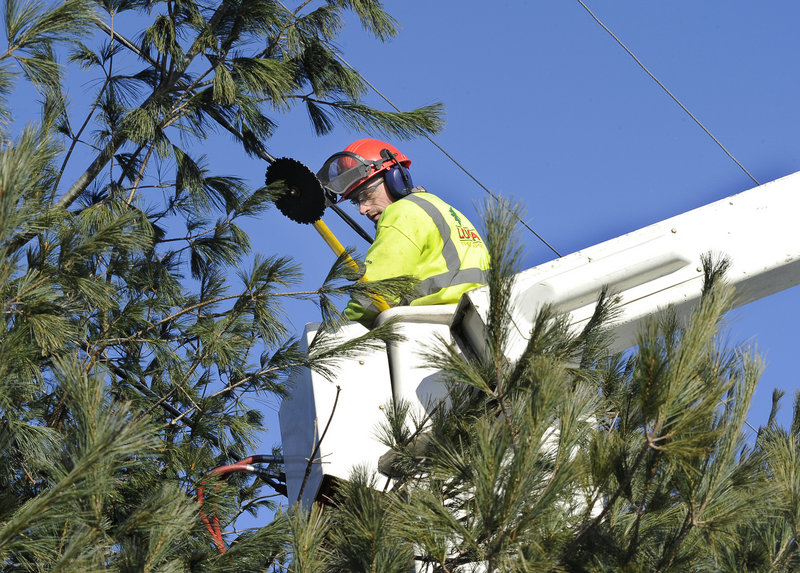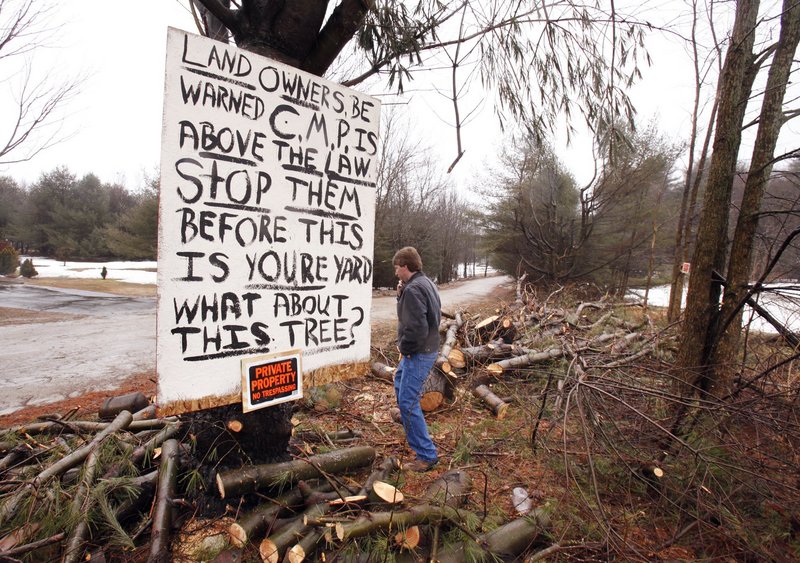WESTBROOK – Howard Jack stood in his driveway last week and watched as a crew from Lucas Tree Experts nipped spruce branches away from the electric lines crossing his lawn. That’s good, he said, but the real problem is the giant maple across the street. A big branch broke and fell on a transformer last spring, knocking out power for four days.
“That’s the tree that needs to come down,” Jack said. “It’s a nightmare waiting to happen.”
Few issues anger electric customers more than extended power interruptions, so for Jack, the sight of a tree-trimming crew in the neighborhood was welcomed. Tree branches coming in contact with wires is the leading cause of outages in Central Maine Power Co.’s service territory, a consultant recently determined.
Maybe that’s not a revelation; Maine is the most heavily forested state in the country. But formal recognition of this fact is changing the way CMP controls tree growth along its 23,000 miles of distribution lines.
CMP is expanding its tree-pruning program to an unprecedented level, with a commitment to trim each section of line every five years. In the past, some sections didn’t see a saw for a decade. Crews also aim to trim away branches within eight feet of either side of a line, and 15 feet above or below.
CMP is roughly halfway through this stepped-up effort. The results may already be noticeable for people living along the newly trimmed circuits, especially in our digital age. They’ll come home less often to blinking clocks if a limb brushes a line. They’ll spend less time resetting video devices or restarting computers after longer outages.
“It’s probably the most concrete thing we can do to improve service,” said John Carroll, a CMP spokesman.
Dry snow during last week’s blizzard helped hold outages to under 4,000 at the storm’s peak, but the new trimming also seemed to make a difference, he added.
The new rules are contained in a 2008 negotiated rate agreement between CMP and the Maine Public Utilities Commission. They reflect a finding by the agency that CMP could improve reliability and safety on its distribution system with more aggressive trimming.
The current program costs $23 million a year and places 145 tree-trimming crews on the road almost every workday. The cost is being recovered in rates, adding another $1 or so each month to the average home customer’s bill.
Regulators also set new standards that CMP must meet for how often the lights go out, and for how long. Measured as an average, annual index, the thresholds get tougher each year through 2013, as the trim program completes its first cycle. CMP could be fined millions of dollars if it fails to meet these standards.
That said, CMP also is under pressure to balance the requirements with the desire of residents and communities to preserve cherished trees on their properties and roadsides. Sometimes, that means negotiating to prune a bit more, or less, tree by tree.
“Behind these negotiations,” Carroll said, “we have an obligation to the PUC and to our customers.”
Maine’s historic villages, graced by mature trees that may have been planted before electric wires were strung, present special challenges. But many problem trees are simply the result of bad planning by home- owners 30 or 40 years ago.
Down the road from Jack’s house, major utility lines from a substation run along New Gorham Road and connect a small subdivision. At that junction, two white pines are growing into the wires, threatening power reliability in the neighborhood.
The little seedlings didn’t pose a threat 30 years ago — when they were planted on the lawn directly under utility lines. Maybe the homeowner didn’t realize that pines can grow more than a foot a year.
Last March, Lucas Tree and CMP received some bad publicity when crews cut a row of pines and maples that provided privacy for a home in Windham. They were planted under the power lines 32 years earlier.
Under the PUC rules, CMP needs to provide direct notice to towns, and to the public via newspaper ads, at least 30 days before trimming. Crews are supposed to consult with property owners before removing a shade or ornamental tree, among other requirements.
Crews do try to be sensitive to public concerns while clearing the lines, according to Ken Lawrence, a lead foreman on the Lucas Tree crew last week.
“It’s a pretty hard job, trying to keep the landowner happy,” he said. “We try to work with the landowner as much as we can.”
Sometimes tree crews call in CMP’s arborist, David Whitworth, to handle the negotiations.
One challenge, Whitworth said, is explaining the new trim guidelines. In the past, CMP would try to notch out limbs of big shade trees to allow the wires to pass through. Now they’re more likely to cut limbs away to achieve the new clearances.
“We get called ‘tree butchers’ all the time, because of what we have to do with these trees,” he said.
And sometimes, Whitworth said, trees that pose the biggest threat to power outages aren’t even within CMP’s trim clearances. The huge maple across from Howard Jack’s house is a prime example. It’s on private property and well away from electric lines — until a branch breaks and falls.
Staff Writer Tux Turkel can be contacted at 791-6462 or at:
tturkel@pressherald.com
Send questions/comments to the editors.





Comments are no longer available on this story